Chapter: 10th Science : Chapter 5 : Acoustics
Sound Waves
SOUND WAVES
When you think about
sound, the questions that arise in your minds are: How is sound produced? How
does sound reach our ears from various sources? What is sound? Is it a force or
energy? Let us answer all these questions.
By touching a ringing
bell or a musical instrument while it is producing music, you can conclude that
sound is produced by vibrations. The vibrating bodies produce energy in the
form of waves, which are nothing but sound waves (Figure 5.1).
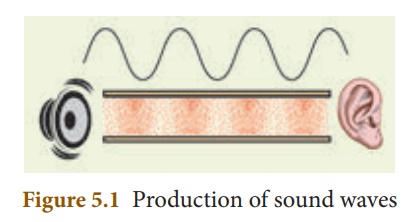
Suppose you and your
friend are on the Moon. Will you be able to hear any sound produced by your
friend? As the Moon does not have air, you will not be able to hear any sound
produced by your friend. Hence, you understand that the sound produced due to
the vibration of different bodies needs a material medium like air, water,
steel, etc, for its propagation. Hence, sound can propagate through a gaseous
medium or a liquid medium or a solid medium.
1. Longitudinal Waves
Sound waves are
longitudinal waves that can travel through any medium (solids, liquids, gases)
with a speed that depends on the properties of the medium. As sound travels
through a medium, the particles of the medium vibrate along the direction of
propagation of the wave. This displacement involves the longitudinal
displacements of the individual molecules from their mean positions. This
results in a series of high and low pressure regions called compressions and
rarefactions as shown in figure 5.2.
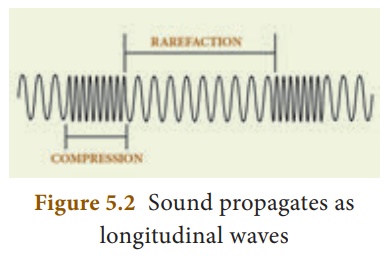
2. Categories of sound waves based on their frequencies
(i) Audible waves – These are sound waves with a frequency
ranging between 20 Hz and 20,000 Hz. These are generated by vibrating bodies
such as vocal cords, stretched strings etc.
(ii) Infrasonic waves – These are sound waves with a frequency
below 20 Hz that cannot be heard by the human ear. e.g., waves produced during
earth quake, ocean waves, sound produced by whales, etc.
(iii) Ultrasonic waves
– These are sound waves with a frequency
greater than 20 kHz, Human ear cannot detect these waves, but certain creatures
like mosquito, dogs, bats, dolphins can detect these waves. e.g., waves
produced by bats.
3. Difference between the sound and light waves
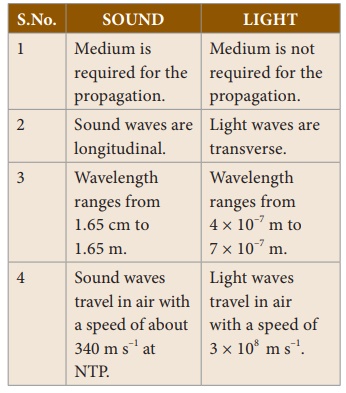
4. Velocity of sound waves
When you talk about the
velocity associated with any wave, there are two velocities, namely particle
velocity and wave velocity. SI unit of velocity is metre (m)
Particle velocity:
The velocity with which
the particles of the medium vibrate in order to transfer the energy in the form
of a wave is called particle velocity.
Wave velocity:
The velocity with which
the wave travels through the medium is called wave velocity. In other words,
the distance travelled by a sound wave in unit time is called the velocity of a
sound wave.
∴
Velocity = Distance / Time taken

If the distance
travelled by one wave is taken as one wavelength (λ) and, the time taken for
this propagation is one time period (T), then, the expression for velocity can
be written as
∴
V = λ/T (5.1)

Therefore, velocity can
be defined as the distance travelled per second by a sound wave. Since,
Frequency (n) =1/T, equation (5.1) can be written as
V = nλ (5.2)
Velocity of a sound wave
is maximum in solids because they are more elastic in nature than liquids and
gases. Since, gases are least elastic in nature, the velocity of sound is the
least in a gaseous medium.
So, vS > vL > vG
5. Factors affecting velocity of sound
In the case of solids,
the elastic properties and the density of the solids affect the velocity of
sound waves. Elastic property of solids is characterized by their elastic
moduli. The speed of sound is directly proportional to the square root of the
elastic modulus and inversely proportional to the square root of the density.
Thus the velocity of sound in solids decreases as the density increases whereas
the velocity of sound increases when the elasticity of the material increases.
In the case of gases, the following factors affect the velocity of sound waves.
Effect of density: The velocity of sound in
a gas is inversely
proportional to the square root of the density of the gas. Hence, the velocity
decreases as the density of the gas increases.

Effect of temperature:
The velocity of sound in
a gas is directly proportional to the square root of its temperature. The
velocity of sound in a gas increases with the increase in temperature. v ∝
√T. Velocity at temperature T is given by the following equation:
vT = (vo + 0.61 T) m s–1
Here, vo is
the velocity of sound in the gas at 0° C. For air, vo = 331 m s–1.
Hence, the velocity of sound changes by 0.61 m s–1 when the
temperature changes by one degree celsius.
Effect of relative
humidity: When
humidity
increases, the speed of
sound increases. That is why you can hear sound from long distances clearly
during rainy seasons.
Speed of sound waves in
different media are given in table 5.1.
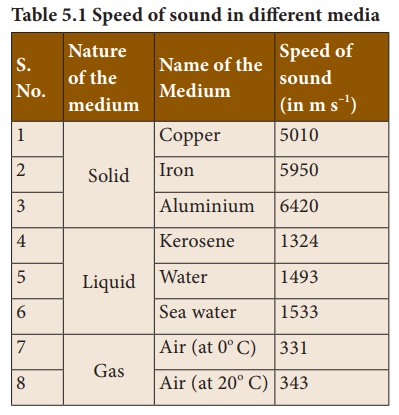
Example Problem 5.1
At what temperature will
the velocity of sound in air be double the velocity of sound in air at 0o
C?
Solution:
Let To
C be the required temperature. Let v1 and v2 be the
velocity of sound at temperatures T1K and T2K
respectively. T1 = 273K (0o C) and T2 = (To
C + 273)K
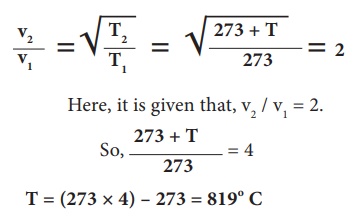
T = (273 × 4) – 273 =
819º C
Related Topics